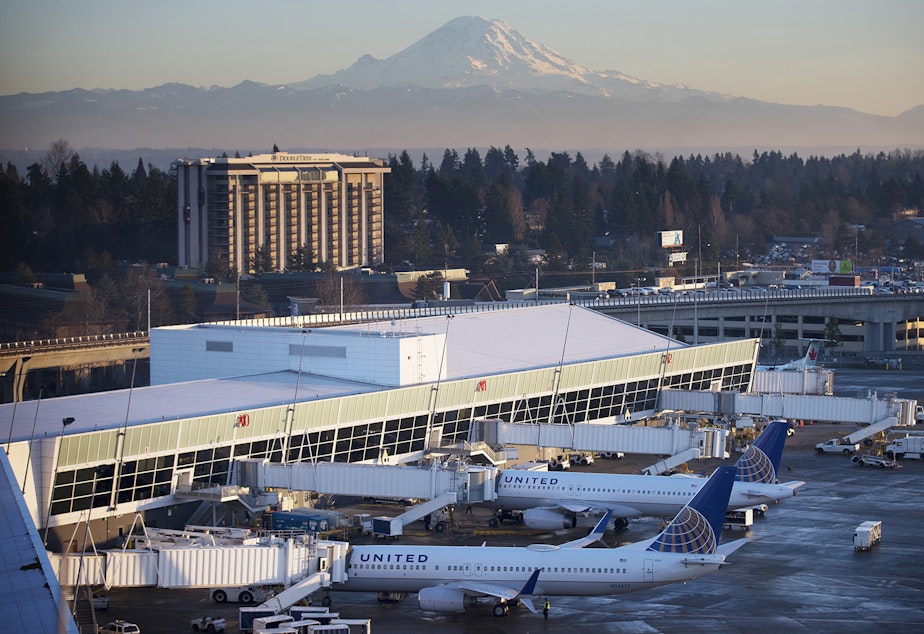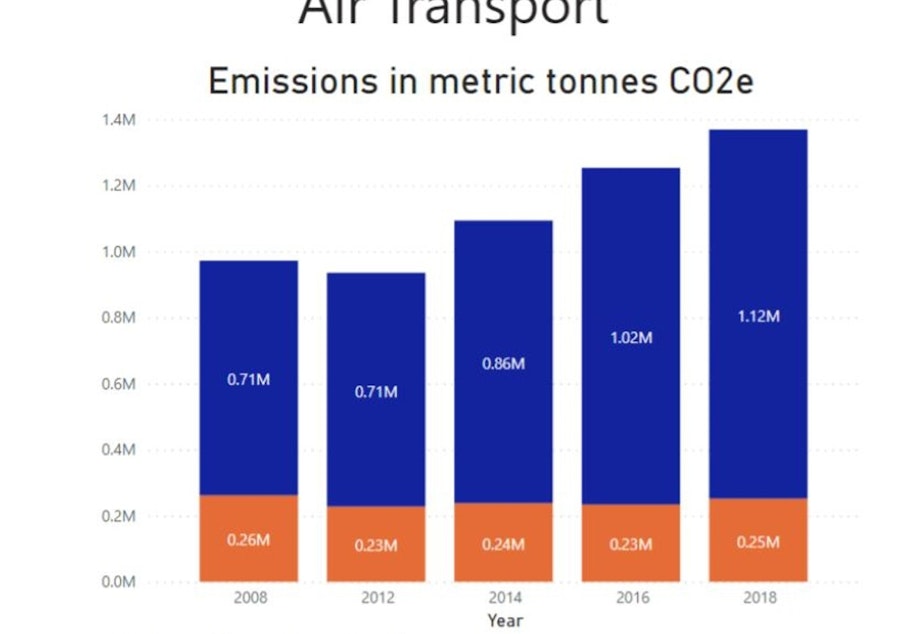
BY  John Ryan
John Ryan
Sea-Tac Airport is currently reporting more takeoffs and landings than at any time since early March 2020. That was in the early days of the Covid-19 pandemic, when travel of all kinds took a nose dive.
The airport has also been planning to boost the number of flights it handles well beyond pre-pandemic levels, a prospect that alarms activists in neighboring communities. They say the air they breathe has already polluted, their health. And they say they are already harmed by incessant overhead noise, and the global climate unraveling.
While correlation is not causation, the rates of heart disease, stroke and premature births all get worse the closer you live to Sea-Tac Airport.
“People in airport communities face disparities in health outcomes, health risk factors, and resources,” Kris Johnson with Public Health Seattle-King County said.
Johnson was addressing a University of Washington-hosted meeting on the local impacts of two major airports: Sea-Tac and Boston’s Logan International Airport.
Johnson said air quality suffers as much as 10 miles away from Sea-Tac Airport.
Activists call the disparities around big airports an environmental injustice.
Communities within 10 miles of Sea-Tac Airport are home to a majority of King County’s Blacks and Latinos, but only a third of the county’s white people.
Researchers at the University of Washington and elsewhere are studying the impacts of ultrafine particulates from jet exhaust and whether filters or vegetation can protect residents from the microscopic particles so small that they can not only lodge in the lungs, but go into the bloodstream and the brain.
Tufts University researcher Neelakshi Hudda has studied concentrations of these tiniest of particulates downwind of Boston’s Logan International Airport. She said the pollution at homes as much as 2.5 miles from the airport spikes when jets are landing overhead and is sometimes worse than the pollution found on an interstate highway.
“No surprise,” Hudda said. “These are people living under a highway. It’s a highway in the sky.”
SeaTac Airport officials say little is known about the ultrafine particles emitted by jets. The Airport provided $75,000 to a recent University of Washington study of the unregulated pollutant.
“We certainly look forward to having an understanding of what the relationship is between airport operations and community exposure, but that has not been definitively established yet,” airport environment director Arlyn Purcell said.
“We know noise causes health problems. We know emissions from the airport cause health problems,” said longtime activist Debi Wagner of Burien. “And that the combined effects of the two are more serious.”
“Aircraft fly over us every 90 to 180 seconds, from 70 to 90 decibels. We get 70% of aircraft landing at Sea-Tac, and we are not eligible for mitigation,” Beacon Hill Councilmember Maria Batayola said.
Batayola said airport communities’ concerns about the flights over their heads have broadened from the local to the global.
“It is now an existential climate issue with a nine-year window to address it,” she said.
Purcell said the airport’s efforts to reduce jet fuel use will also reduce air pollution of various kinds.
“The port has worked aggressively to reduce carbon emissions, and the more that we’re able to reduce carbon emissions, the more benefits there are for local air pollutant emissions,” Purcell said.
Purcell said the airport aims to replace 10% of its jet fuel with biofuel by 2028. In addition to reducing carbon emissions, Purcell said, the biofuel produces 80% less particulates than petroleum-based jet fuel.
Activists say the airport’s pollution-trimming efforts pale beside its ever-rising volumes of air traffic and consumption of jet fuel.

The airport is currently looking to build a new terminal and 19 new gates by 2027 and expand aircraft operations 25% over 2019 levels by 2029. Sea-Tac officials are currently preparing planning documents for the proposed expansion for review by state and federal agencies and the public.
Rep. Adam Smith, whose district includes Sea-Tac Airport, said he has been trying to get the Federal Aviation Administration to take airport neighbors’ concerns more seriously.
“The FAA’s mandate right now is: Move people, move cargo, and the impact on the community is someone else’s problem,” Smith said.
Sea-Tac Airport officials say their mandate is to meet the public’s demand for air travel, not to boost or curtail it.
“The airport is not working to attract more operations or passengers, rather we are trying to manage service for what is coming as our region is one of the fastest growing in the country,” spokesperson Perry Cooper said in an email.
